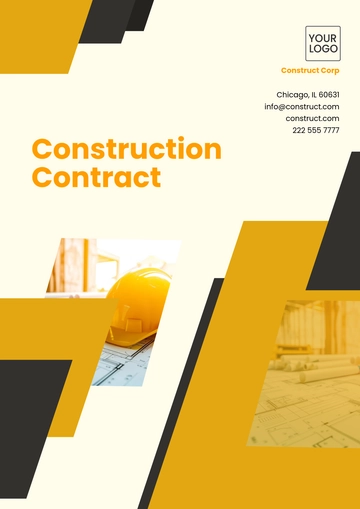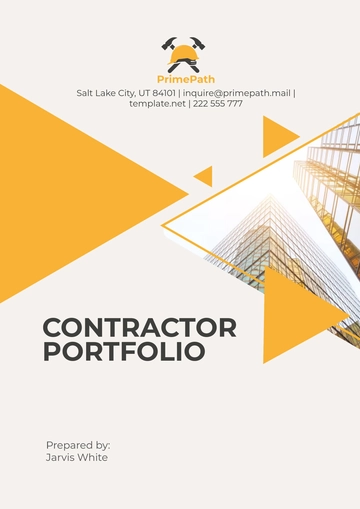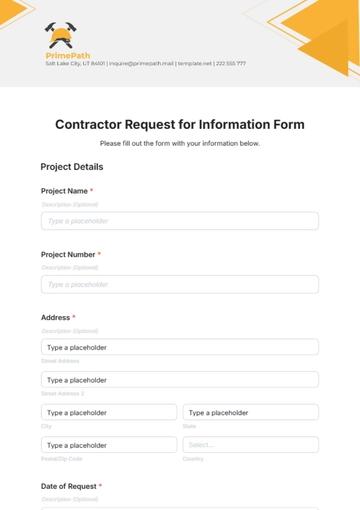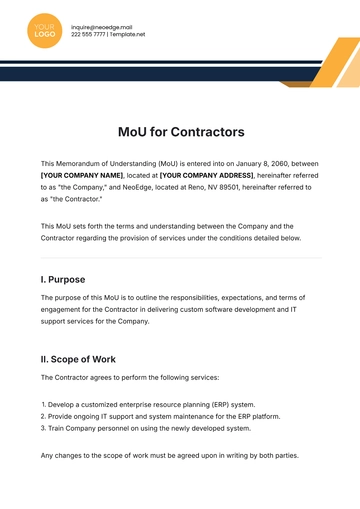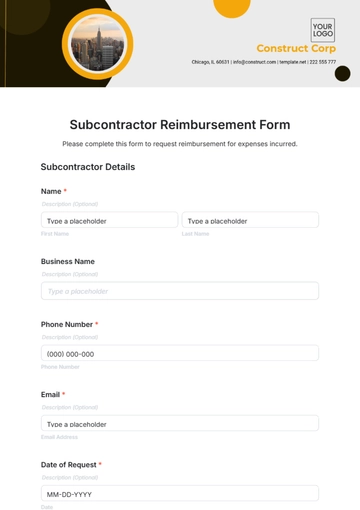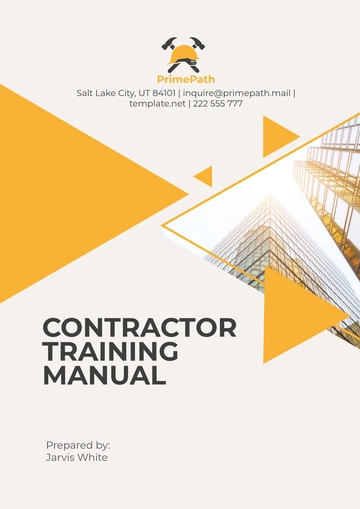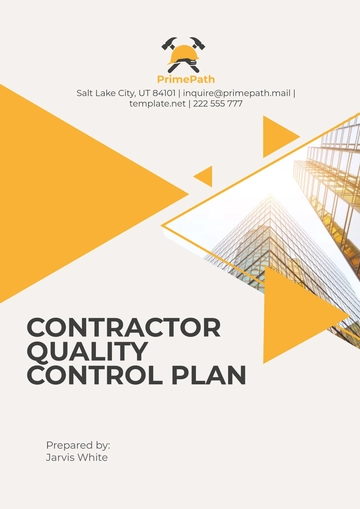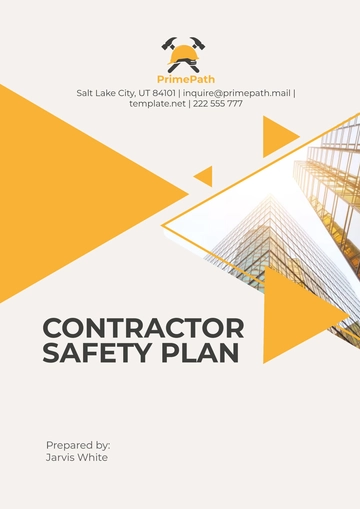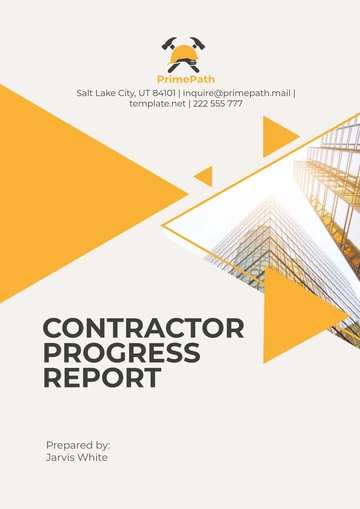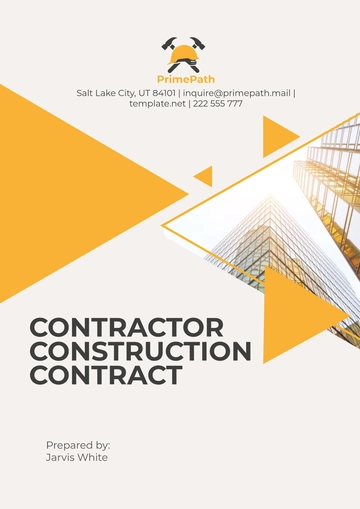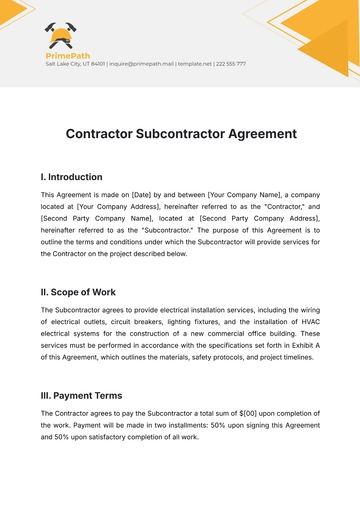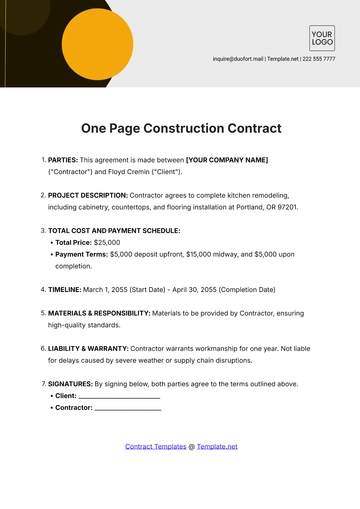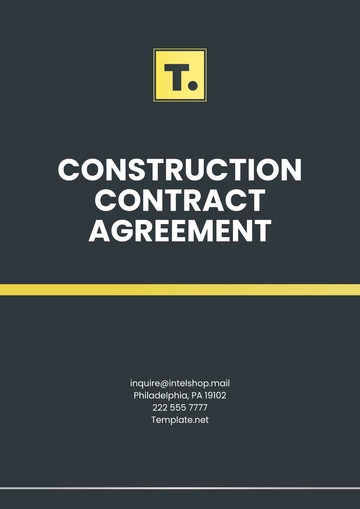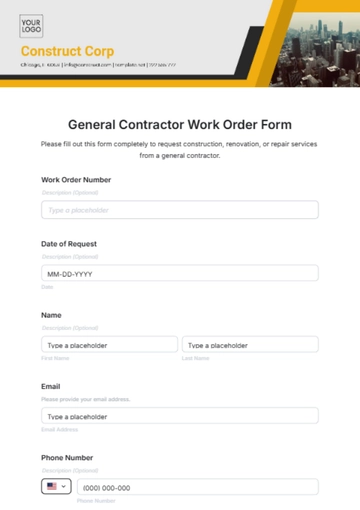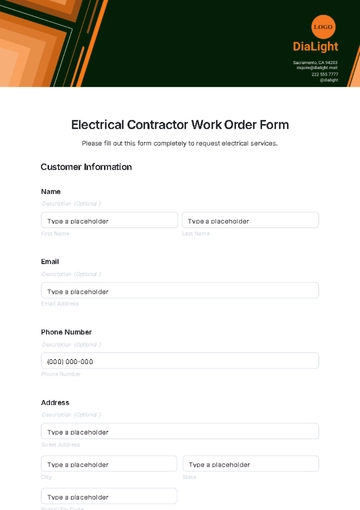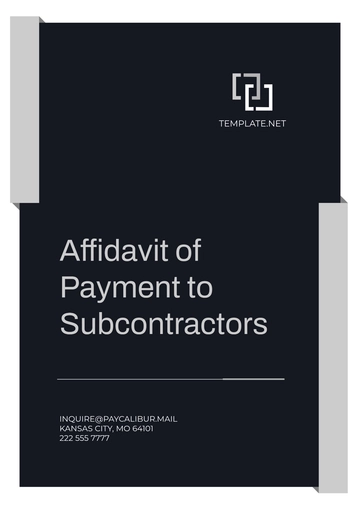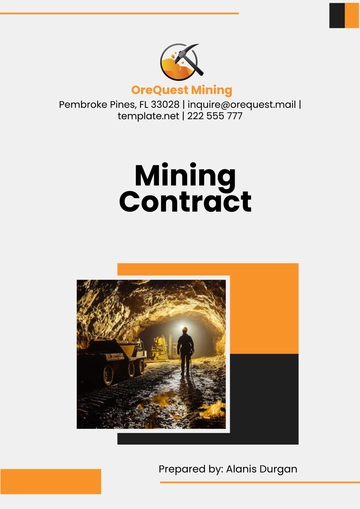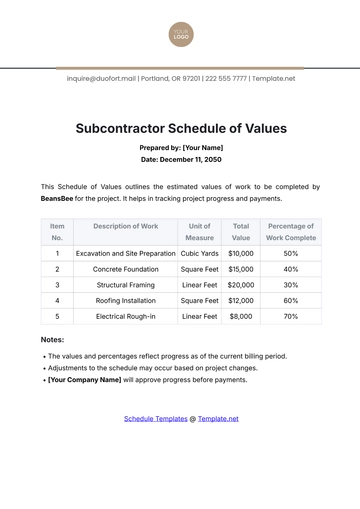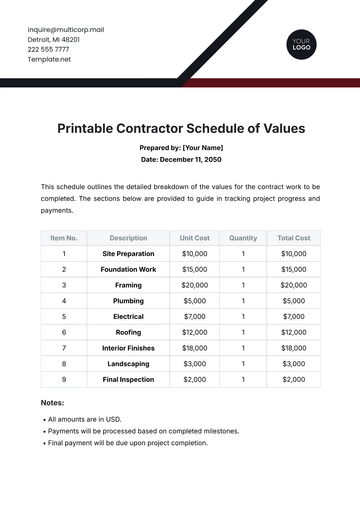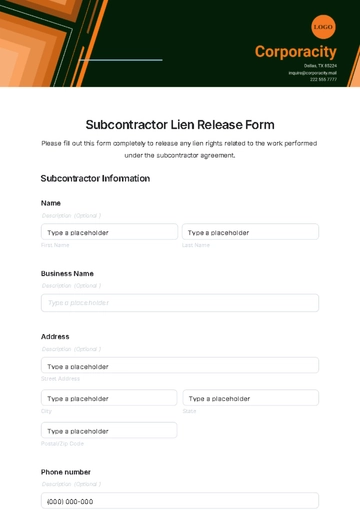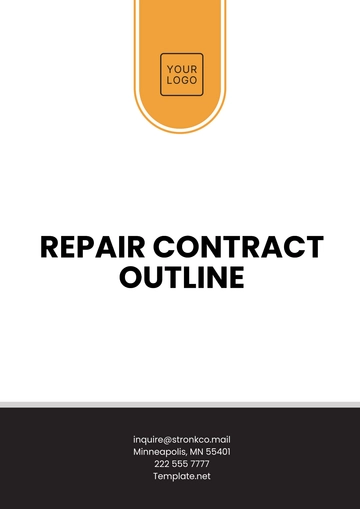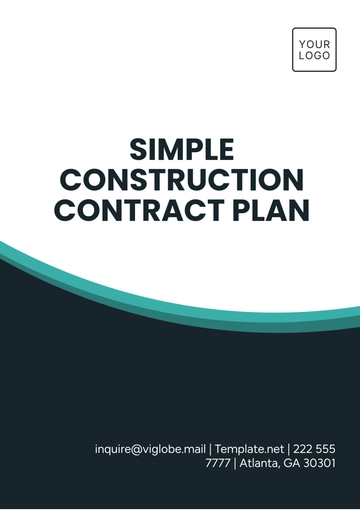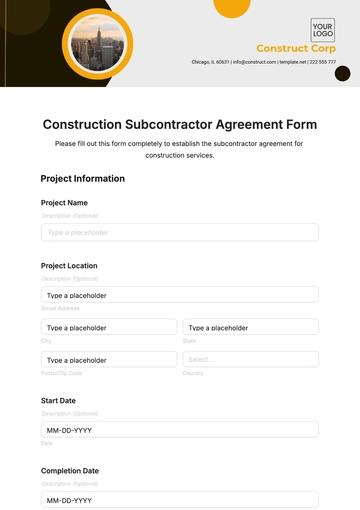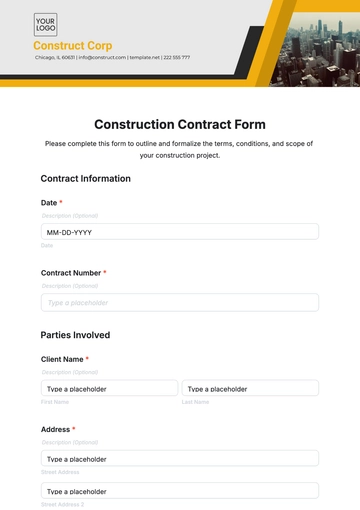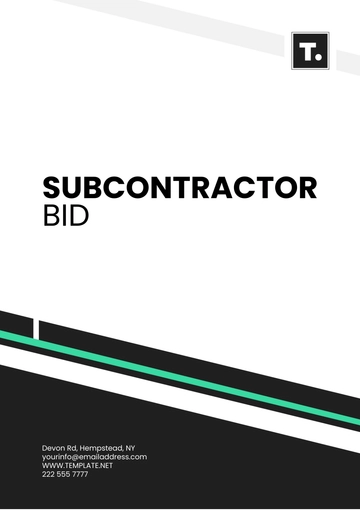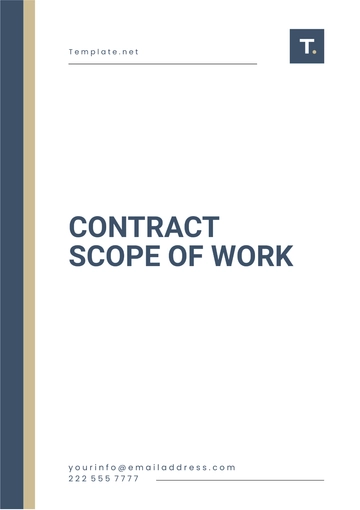Free Construction Contract Brief
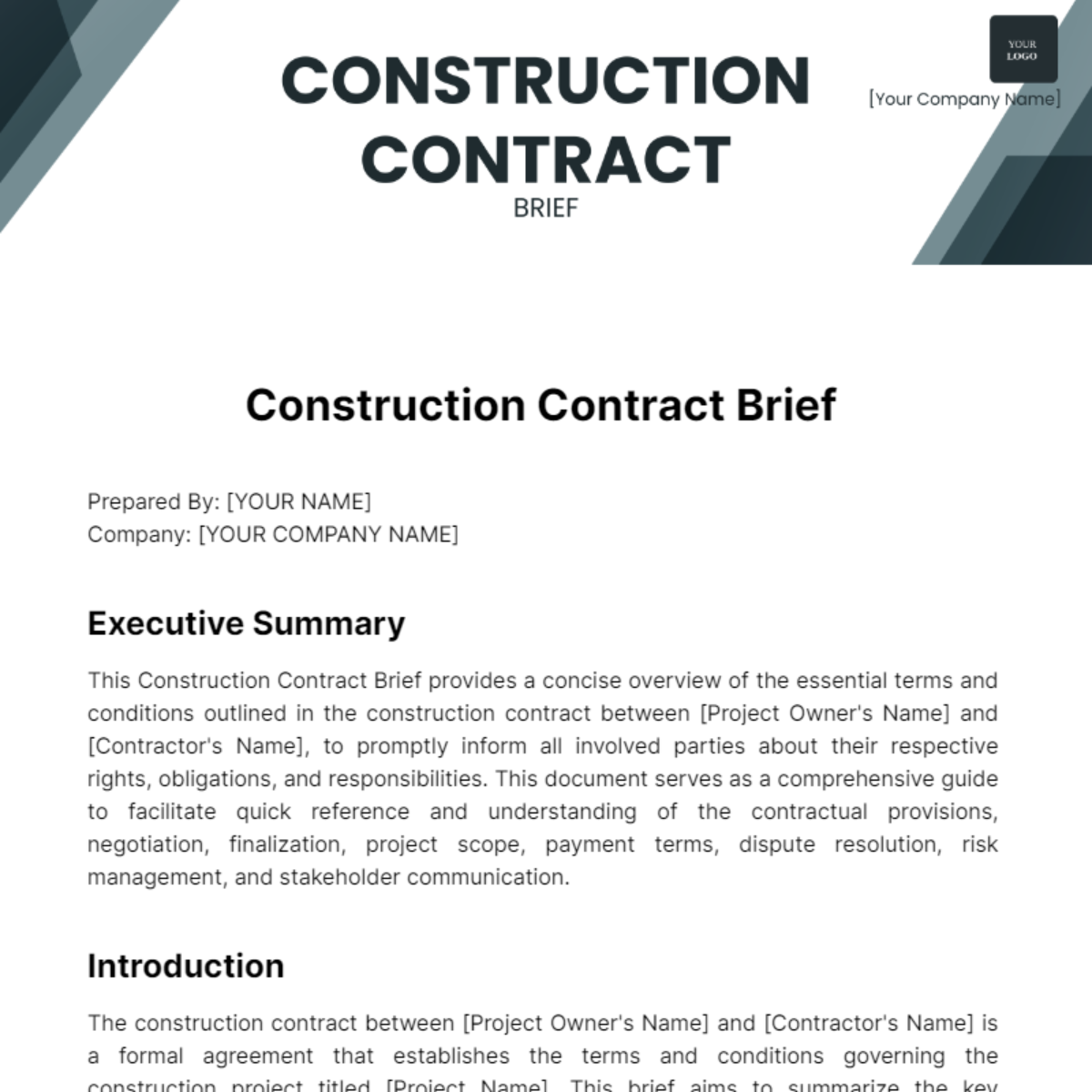
Prepared By: [YOUR NAME]
Company: [YOUR COMPANY NAME]
Executive Summary
This Construction Contract Brief provides a concise overview of the essential terms and conditions outlined in the construction contract between [Project Owner's Name] and [Contractor's Name], to promptly inform all involved parties about their respective rights, obligations, and responsibilities. This document serves as a comprehensive guide to facilitate quick reference and understanding of the contractual provisions, negotiation, finalization, project scope, payment terms, dispute resolution, risk management, and stakeholder communication.
Introduction
The construction contract between [Project Owner's Name] and [Contractor's Name] is a formal agreement that establishes the terms and conditions governing the construction project titled [Project Name]. This brief aims to summarize the key elements of the contract, ensuring clarity and alignment among all parties involved.
Quick Reference and Understanding
This section offers a succinct overview of the primary contractual provisions to facilitate quick comprehension and reference for all parties involved:
Scope of Work:
Defines the specific tasks, responsibilities, and deliverables expected from the contractor during the construction project.
Outlines any technical specifications, quality standards, and compliance requirements that must be adhered to.
Project Timeline:
Specifies the start and end dates of the project.
Identifies key milestones, deadlines, and phases of the construction process.
Provides a clear timeline for completing each stage of the project to ensure timely delivery.
Payment Terms:
Details the agreed-upon payment structure, including the total contract amount, payment schedule, and methods of payment.
Clarifies any provisions regarding advance payments, progress payments, and final payment upon project completion.
Dispute Resolution Mechanisms:
Establishes procedures for resolving disputes or conflicts that may arise during the project.
Specifies whether disputes will be resolved through mediation, arbitration, or litigation.
Defines the steps and timelines for initiating and conducting dispute resolution processes.
Insurance and Liability Provisions:
Outlines the insurance requirements for the project, including types and coverage limits.
Specifies liability limitations and indemnification provisions to allocate risks appropriately among the parties involved.
Ensures that adequate insurance coverage is in place to protect against potential liabilities and losses.
Stakeholder Responsibilities:
Delineates the roles, responsibilities, and obligations of each party involved in the construction project, including the project owner, contractor, subcontractors, and any other stakeholders.
Identifies specific tasks, duties, and expectations for each party to ensure effective collaboration and project management.
Negotiation and Finalization
The negotiation and finalization process of the contract between [Project Owner's Name] and [Contractor's Name] involved several key stages to ensure mutual agreement and alignment of interests:
Initial Proposal Review: Both parties reviewed the initial proposal, outlining the project scope, timelines, deliverables, and associated costs. Any discrepancies or areas of concern were identified for further discussion.
Negotiation Meetings: Negotiation meetings were held to discuss and negotiate specific terms and conditions of the contract. This included areas such as project milestones, payment schedules, change order procedures, and dispute resolution mechanisms.
Documenting Amendments: Throughout the negotiation process, any amendments or additions to the contract were meticulously documented. This included drafting revised clauses or adding new provisions to address concerns raised by either party.
Legal Review: Legal representatives from both parties reviewed the contract to ensure compliance with relevant laws and regulations. Any legal implications or risks were carefully evaluated and addressed during this stage.
Final Agreement: After multiple rounds of negotiation and review, a final agreement was reached between [Project Owner's Name] and [Contractor's Name]. All parties were satisfied with the terms and conditions outlined in the contract.
Signing and Execution: Once the contract terms were finalized, all parties signed the document to signify their agreement and commitment to fulfilling their respective obligations. Copies of the signed contract were provided to each party for their records.
Continuous Communication: Throughout the negotiation and finalization process, open and transparent communication was maintained between [Project Owner's Name] and [Contractor's Name]. This ensured that any concerns or issues were addressed promptly, fostering a collaborative and constructive working relationship.
Clarity on Project Scope and Deliverables
The scope of work outlined in the construction contract encompasses a comprehensive set of deliverables, milestones, and specifications essential for the successful completion of the [Project Name] project. Below are specific details regarding the project scope and deliverables:
Scope of Work: The contract delineates the specific tasks and activities to be undertaken by the contractor by the project requirements. This includes but is not limited to:
Site preparation and clearing
Foundation construction
Structural framework erection
Installation of utilities (plumbing, electrical, HVAC)
Interior and exterior finishing
Landscaping and site restoration
Deliverables: The contract specifies the tangible outputs or products to be delivered upon completion of various project phases. These deliverables may include:
Architectural drawings and plans
Engineering calculations and reports
Construction materials and equipment
Completed structures or buildings
Milestones: Key project milestones are clearly defined to track progress and ensure timely completion. These milestones include:
Commencement of construction
Completion of foundation work
Structural framing completion
Interior fit-out and finishing
Final inspection and handover
Specifications: Detailed specifications are provided for materials, equipment, and construction methods to be utilized throughout the project. This ensures compliance with quality standards and regulatory requirements. Specifications cover aspects such as:
Material types and grades
Equipment specifications (e.g., HVAC systems, plumbing fixtures)
Construction techniques and methodologies
Quality assurance and control measures
Payment Terms and Dispute Resolution
Payment Terms:
Invoicing Procedures: Invoices shall be submitted by the Contractor to the Project Owner every month, detailing the completed work, materials supplied, and any applicable expenses incurred during the billing period. The Project Owner agrees to make payments within [insert number of days] days of receipt of the invoice, subject to the terms outlined herein.
Milestone Payments: Payment milestones have been established to coincide with significant stages of the construction project. These milestones and their corresponding payment amounts are detailed in Schedule A of the contract. The Contractor shall submit a request for payment upon the completion of each milestone, accompanied by supporting documentation to verify the completion of work.
Final Payment Conditions: Upon the successful completion and acceptance of all work outlined in the contract, the Project Owner agrees to make the final payment to the Contractor within [insert number of days] days of the project's completion. Final payment shall be contingent upon the Contractor's submission of all necessary documentation, including lien waivers, warranties, and final project closeout reports.
Dispute Resolution:
In the event of any disputes or disagreements arising between the Project Owner and the Contractor during the construction project, the following procedures shall be followed:
Negotiation: The parties agree to first attempt to resolve any disputes amicably through good-faith negotiations. Both parties shall designate representatives with the authority to negotiate and settle disputes on their behalf.
Mediation: If negotiations fail to resolve the dispute within a reasonable timeframe, the parties agree to submit the matter to mediation. A mutually agreed-upon mediator shall facilitate discussions between the parties to reach a mutually acceptable resolution.
Arbitration: If mediation is unsuccessful in resolving the dispute, either party may initiate arbitration proceedings. The arbitration shall be conducted by the rules and procedures of [insert name of arbitration organization] and shall be binding on both parties. Each party agrees to bear the costs associated with arbitration unless otherwise determined by the arbitrator.
Litigation: If arbitration is deemed ineffective or unenforceable, either party may pursue legal action through litigation in the appropriate court jurisdiction.
Risk Management
Risk Management in the construction contract entails several specific provisions aimed at mitigating risks and protecting the interests of all parties involved. Here are the key elements included in the risk management section:
Insurance Requirements: The contract specifies the types and levels of insurance coverage required for the project. This typically includes general liability insurance, worker's compensation insurance, and builder's risk insurance. Each party's obligations regarding obtaining and maintaining insurance coverage are clearly outlined.
Warranties: The contract outlines any warranties provided by the contractor for the work performed and materials used in the construction project. This may include warranties for workmanship, materials, and equipment, with specified durations and conditions for invoking warranty claims.
Indemnification: Provisions for indemnification detail the responsibilities of each party to compensate the other for losses, damages, or liabilities arising from the construction project. Indemnification clauses specify the scope of indemnity, exceptions, and limitations, ensuring that each party bears responsibility for its actions and liabilities.
Liability Limitations: The contract sets forth limitations on liability for each party involved in the construction project. This includes caps on liability amounts, exclusions for certain types of damages, and procedures for resolving liability disputes. Clear delineation of liability limits helps manage financial risks and ensures accountability among the parties.
Risk Allocation: The contract allocates specific risks among the parties involved, taking into account factors such as expertise, control, and financial capacity. Risk allocation provisions may assign responsibility for certain risks to the party best equipped to manage or mitigate them, reducing overall project risk exposure.
Change Order Procedures: The contract establishes procedures for managing changes to the project scope, schedule, or budget. This includes requirements for documenting change orders, obtaining approval from relevant parties, and addressing any resulting impacts on insurance coverage, warranties, or indemnification obligations.
Dispute Resolution Mechanisms: In the event of disputes related to risk management issues, the contract outlines procedures for resolving conflicts through negotiation, mediation, arbitration, or litigation. Clear dispute resolution mechanisms help minimize disruptions to the project and facilitate the timely resolution of issues.
Stakeholder Communication and Collaboration
Stakeholder Communication and Collaboration
The success of any construction project heavily relies on effective communication and collaboration among all stakeholders. By the contract, the following measures are implemented to ensure seamless interaction and cooperation throughout the project lifecycle:
Stakeholder Roles and Responsibilities:
The contract explicitly outlines the roles and responsibilities of each stakeholder, including the project owner, contractor, subcontractors, architects, engineers, and any other relevant parties.
Clear delineation of duties ensures that each stakeholder understands their contributions to the project's success and fosters accountability.
Communication Channels:
Designated communication channels are established for exchanging project-related information, such as emails, project management software platforms, and scheduled meetings.
These channels serve as primary conduits for disseminating updates, addressing concerns, and facilitating decision-making processes promptly.
Regular Meetings:
Scheduled meetings, including kick-off meetings, progress reviews, and milestone evaluations, are conducted at predetermined intervals throughout the project lifecycle.
These meetings provide opportunities for stakeholders to discuss project status, resolve issues, and realign objectives as necessary.
Progress Updates:
Regular progress updates are communicated to all stakeholders to keep them informed about project advancements, challenges, and any deviations from the initial plan.
Transparent reporting of project milestones, timelines, and budgetary considerations promotes trust and accountability among stakeholders.
Issue Resolution Protocol:
An established protocol for issue resolution is in place to address any conflicts, discrepancies, or unforeseen challenges that may arise during the construction process.
This protocol outlines escalation procedures, responsible parties for resolution, and timelines for addressing issues to prevent delays and maintain project momentum.
Change Management Procedures:
Protocols for managing changes to the project scope, schedule, or budget are documented to ensure that modifications are properly evaluated, approved, and integrated into the project plan.
Stakeholders are involved in change management discussions to assess the impact of proposed changes and make informed decisions collaboratively.
Documentation and Reporting:
Comprehensive documentation of project communications, decisions, and agreements is maintained throughout the project lifecycle.
Regular reporting mechanisms are implemented to provide stakeholders with clear insights into project performance, risks, and mitigation strategies.
Conclusion
This Construction Contract Brief provides a comprehensive summary of the key terms and conditions outlined in the construction contract between [Project Owner's Name] and [Contractor's Name]. It is designed to facilitate quick reference and understanding, ensuring that all parties involved are fully informed about their respective obligations and responsibilities. Any questions or concerns regarding the contract terms should be addressed promptly to maintain a successful and collaborative working relationship throughout the project.
- 100% Customizable, free editor
- Access 1 Million+ Templates, photo’s & graphics
- Download or share as a template
- Click and replace photos, graphics, text, backgrounds
- Resize, crop, AI write & more
- Access advanced editor
Introducing the Construction Contract Brief Template from Template.net: your essential companion for seamless contract management. This customizable and editable template simplifies the construction contract process, ensuring accuracy and efficiency. Tailor every aspect effortlessly with our Ai Editor Tool, perfecting it to your project's requirements. Simplify contract management and elevate your construction projects with ease, exclusively on Template.net.
You may also like
- Rental Contract
- Contractor Contract
- Contract Agreement
- One Page Contract
- School Contract
- Social Media Contract
- Service Contract
- Business Contract
- Restaurant Contract
- Marketing Contract
- Real Estate Contract
- IT Contract
- Cleaning Contract
- Property Contract
- Supplier Contract
- Partnership Contract
- Food Business Contract
- Construction Contract
- Employment Contract
- Investment Contract
- Project Contract
- Payment Contract
- Student Contract
- Travel Agency Contract
- Startup Contract
- Annual Maintenance Contract
- Employee Contract
- Gym Contract
- Event Planning Contract
- Personal Contract
- Nursing Home Contract
- Law Firm Contract
- Work from Home Contract
- Software Development Contract
- Maintenance Contract
- Music Contract
- Amendment Contract
- Band Contract
- DJ Contract
- University Contract
- Salon Contract
- Renovation Contract
- Photography Contract
- Lawn Care Contract
